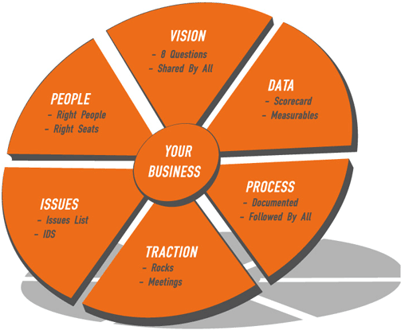Wake up, Neo... follow the white rabbit, take the red pill (or was it the blue?), there is no spoon, you are the one, you're not the one, was that really the exact same black cat?
STOP! We're here to interrupt the constant stream of questions you're pondering and conflicting directions you're getting after reading books about marketing.
We are serious about your brand being a movie, however. At least in theory, of course. That’s the premise of Building a StoryBrand (more on that below), a book that treats your marketing messaging like a movie script.
So Much to Read, So Little Time
There are a lot, emphasis A LOT of business and marketing books out there. Some good, some bad, some groundbreaking, and some that make you say, “Duh!”
What we’ve put together here is a list of some of our favorite marketing books. This is by no means an exhaustive list, simply a compilation of the books that have stood the test of time in our opinion. Meaning, we keep going back to reference notes, earmarks, quotes and ultimately use our learnings as part of the work we do every day as a marketing agency.
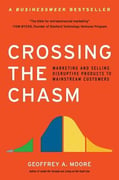 Crossing the Chasm (1991)
Crossing the Chasm (1991)
by Geoffrey A. Moore
Remember 1991? The original George Bush was president, the Internet wasn’t really a thing yet, and Crossing the Chasm was released. Interestingly, this book is primarily about technology companies before the Internet boom. However, it is still as relevant today as it was decades ago.
The main idea Moore gives us is that a chasm (gap) exists between the early adopters of a product or service and the early majority. For context, there is an average audience life cycle that consists of five stages:
- Innovators
- Early Adopters
- Early Majority
- Late Majority
- Laggards (yes, that is the real term used)
 Image Source: https://blog.prototypr.io/design-for-crossing-the-chasm-1c4d4c68a3f1
Image Source: https://blog.prototypr.io/design-for-crossing-the-chasm-1c4d4c68a3f1
Understanding this life cycle is critical for every business because you have to be aware of what stage you’re at, and how you need to adjust your business in response to it.
We use this book as a model because we often are engaged with clients as they are approaching or sitting on the edge of the gap. Up until now, your business has been growing, but you find yourself stuck. The fragmented systems, processes, and teams that have worked until now are now holding you back.
Using tools from Crossing the Chasm, we help teams both in their internal and external focuses find their footing to get across the gap and grow through marketing efforts, establishing strong, connected platforms, and setting smart goals that a team can rally around.
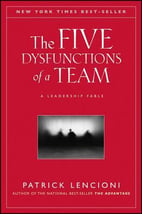
The Five Dysfunctions of a Team (2002)
by Patrick Lencioni
Although this is technically not a marketing book, it has many applications that we find ourselves using over and over again with our clients.
A great brand starts with a great business, including our own marketing agency, which is why we love this book. Lencioni presents a fictional business to mirror many situations we find ourselves in. He theorizes that, as the title suggests, there are five things that make or break a team:
- Absence of trust
- Fear of conflict
- Lack of commitment
- Avoidance of accountability
- Inattention to results
At first glance, these may seem obvious, but an attentive read of the book or even an in-depth review reveals why these components are so important for great teamwork.
We use these principles in numerous ways: how our team works together, how we work with a client’s team, how we help client’s internal teams work together, how our clients work with their audience, etc.
Marketing is ultimately another word for communication. Purposeful, often business-related communication, communication nonetheless. If we can’t be successful communicating amongst ourselves, how can we expect to spend our money and time and our audience’s money and time on poorly communicated ideas?

Traction (2007)
by Gino Wickman
On this list, we have two books authored by Gino Wickman. We could list a couple of others if we’re being honest, but these were our must lists. First, is Traction. If you are looking for clear-cut plans that you can follow along with, this and StoryBrand are your go-to’s.
Traction introduced the world to EOS (Entrepreneurial Operating System) and rocked businesses by their core. Ten years later in 2017, he released What the Heck is EOS? If you need more material. EOS is a business that you can apply to companies big and small, in growth and stability alike. Wickman presents six factors that every great business needs:
- Vision
- People
- Data
- Issues
- Process
- Traction
Image Source: https://www.eosworldwide.com/eos-model
Traction is the trademarked process of execution. Similar to a newer marketing approach called Agile which breaks objectives down into smaller two-week “Sprints”, Tractions uses “Rocks” which are your 90-day focus points.
What Traction did and still does for our clients to this day is take all of the most important things every business needs, and what teams know they need and put them into a plan that you can then make actionable.
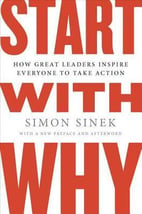 Start With Why (2009)
Start With Why (2009)
by Simon Sinek
We highly recommend reading the book, however, if you’re in a rush, you can actually watch the 18-minute TEDx Talk that distills the main ideas. Start With Why is a great book to break up the pragmatic reads with something more aspirational and emotional.
In the book, Sinek talks at length about what makes great leaders and why leadership is so important. We will just touch on his theory of the Golden Circle, see video, which is like a dartboard with Why in the middle, then How, and finally What. Obviously, you must start in the middle with Why, which is much harder than you think.
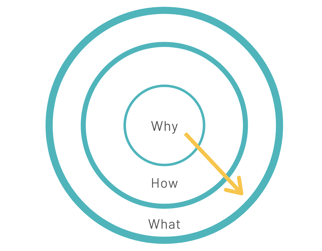
Often we use this exercise with clients to strike at the core of why their business exists. It’s not uncommon to have a 2+ hour meeting without identifying a why. Leaders will name many things the company does, who they help, even why it matters. But truly identifying your why, your mission as it’s regularly referred to, goes deeper and takes a good amount of effort to uncover. Once you see your Why though, the rest falls that much easier into place.
Rock et Fuel (2015)
et Fuel (2015)
by Gino Wickman
The second Wickman book to make our list changes it up from what makes a great business plan to what makes great leadership. Just as our brains have two sides, the creative right, and the logical left, most businesses have two types of leaders; Visionaries and Integrators.
Together, when working in sync, can create a rocket fuel that propels a business forward. Often the Visionary and Integrator are co-founders or first and second in command, but Rocket Fuel applies just as effectively to departments and even smaller teams.
Once you know what to look for, it’s fairly obvious who is who. Luckily, there’s a whole book that can help you maximize this realization. Everything from how to set goals differently, how to assign responsibilities, and how to build relationships amongst teams.
Having this knowledge in our back pocket is critical for getting things done. Sort of like love languages (another good book for another time) you need to know how people respond and interpret things to make sure the information you’re presenting is doomed from the beginning.
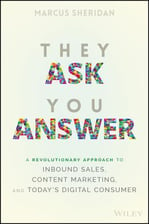 They Ask You Answer (2017)
They Ask You Answer (2017)
by Marcus Sheridan
Content is king, as the saying goes. One book that embodies this sentiment is They Ask You Answer. As the age of the Internet continues to grow, quality content has risen to the top as the differentiator. Sheridan argues that money spent on traditional advertising could be saved and better spent by dedicating time to the free endeavor of writing great content online.
His theory, proven by what all of us do every day, is that when someone (a potential customer specifically) has a question, they search for it online. Wouldn’t you rather be the first result on search engines right at that moment rather than guessing with billboards, radio, and television?
When you make the switch from advertising to answering, and position yourself as a trusted voice to turn to, you become the authentic, authority figure. The strategy of attracting leads with content is most often called inbound marketing. We use inbound methods for almost every client including blogs, social media, web content, newsletters, and more.
Every good marketing plan is a healthy mix of both inbound and outbound content, however, so don’t fail to continue important lead-finding measurable methods like digital ads and remarketing.
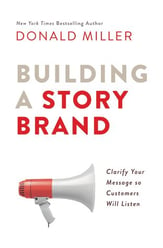 Building a StoryBrand (2017)
Building a StoryBrand (2017)
by Donald Miller
If you skipped to the end, you missed a lot of great books, but we understand. That’s rule number one of a BrandScript, so you better be taking notes already! Understanding your audience is the key to StoryBrand. The enlightened twist that Miller brought to the marketing world is likening a movie script to your brand’s messaging.
Not only is creating a BrandScript useful, but it’s fun which is the secret ingredient. The main idea that StoryBrand is that the audience is the hero of the story, not your business. This is the hard, but necessary part the made StoryBrand so popular and effective. So many models focus internally, or with the customer/client/audience as a piece. But Miller flips the script (bad pun).
In this story, your business is the guide that helps the hero achieve something. You are the Obi-Wan Kenobi to Luke Skywalker trying to destroy the Death Star as Miller puts it. Or helping Luke buy a new land speeder. That script is roughly:
- Character
- Problem
- Guide
- Plan
- Call to Action
- Success/Failure
StoryBrand is a great tool to use when creating a website or content plan because it unlocks how you should be talking to your audience and positioning yourself in that process. We regularly use a BrandScript with clients to help create consistent messaging throughout mediums that laser focuses on making conversions.
Epilogue, or Final Takeaways
There is no one ring (to rule them all) when it comes to marketing. We love to read at 1 Bold Step so we can’t wait to see what the next release to make our list down the road will be. Have we missed a favorite book of yours? Let us know and we’ll add it to our list!
Every client, project, audience, and team is different, so that’s why it’s important to have a strong toolbox. All of these books have played a part in inspiring the work we do and allowing us to help companies optimize and grow.
We highly recommend starting with these if you’re entering the industry, looking to broaden your own toolbox, or if you’re nerdy like us and read business books for fun now and then (with wine if you’re our CEO and Founder, Jen).

